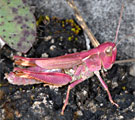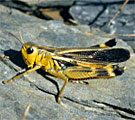Italopodisma fiscellana (La Greca, 1954)
![Italopodisma fiscellana: Male (Italy, Gran Sasso National Park, Campo Imperatore, 2000m, late September 2016) [N] Italopodisma fiscellana: Male (Italy, Gran Sasso National Park, Campo Imperatore, 2000m, late September 2016) [N]](thumbs/catantopidae/italopodisma_sasso_im2016.jpg)
![Italopodisma fiscellana: Male (Italy, Gran Sasso National Park, Campo Imperatore, 2000m, late September 2016) [N] Italopodisma fiscellana: Male (Italy, Gran Sasso National Park, Campo Imperatore, 2000m, late September 2016) [N]](thumbs/catantopidae/italopodisma_sasso_2im2016.jpg)
![Italopodisma fiscellana: Male (Italy, Gran Sasso National Park, Campo Imperatore, 2000m, late September 2016) [N] Italopodisma fiscellana: Male (Italy, Gran Sasso National Park, Campo Imperatore, 2000m, late September 2016) [N]](thumbs/catantopidae/italopodisma_sasso_3im2016.jpg)
![Italopodisma fiscellana: Male (Italy, Gran Sasso National Park, Campo Imperatore, 2000m, late September 2016) [N] Italopodisma fiscellana: Male (Italy, Gran Sasso National Park, Campo Imperatore, 2000m, late September 2016) [N]](thumbs/catantopidae/italopodisma_sasso_4im2016.jpg)
![Italopodisma fiscellana: Male (Italy, Gran Sasso National Park, Campo Imperatore, 2000m, late September 2016) [N] Italopodisma fiscellana: Male (Italy, Gran Sasso National Park, Campo Imperatore, 2000m, late September 2016) [N]](thumbs/catantopidae/italopodisma_sasso_5im2016.jpg)
![Italopodisma fiscellana: Male (Italy, Gran Sasso National Park, Campo Imperatore, 2000m, late September 2016) [N] Italopodisma fiscellana: Male (Italy, Gran Sasso National Park, Campo Imperatore, 2000m, late September 2016) [N]](thumbs/catantopidae/italopodisma_sasso_6im2016.jpg)
![Italopodisma fiscellana: Male (Italy, Gran Sasso National Park, Campo Imperatore, 2100m, late September 2016) [N] Italopodisma fiscellana: Male (Italy, Gran Sasso National Park, Campo Imperatore, 2100m, late September 2016) [N]](thumbs/catantopidae/italopodisma_sasso_7im2016.jpg)
![Italopodisma fiscellana: Male (Italy, Gran Sasso National Park, Campo Imperatore, 2100m, late September 2016) [N] Italopodisma fiscellana: Male (Italy, Gran Sasso National Park, Campo Imperatore, 2100m, late September 2016) [N]](thumbs/catantopidae/italopodisma_sasso_8im2016.jpg)
![Italopodisma fiscellana: Male (Italy, Gran Sasso National Park, Campo Imperatore, 2200m, late September 2016) [N] Italopodisma fiscellana: Male (Italy, Gran Sasso National Park, Campo Imperatore, 2200m, late September 2016) [N]](thumbs/catantopidae/italopodisma_sasso_9im2016.jpg)
![Italopodisma fiscellana: Male (Italy, Gran Sasso National Park, Campo Imperatore, 2200m, late September 2016) [N] Italopodisma fiscellana: Male (Italy, Gran Sasso National Park, Campo Imperatore, 2200m, late September 2016) [N]](thumbs/catantopidae/italopodisma_sasso_10im2016.jpg)
![Italopodisma fiscellana: Male (Italy, Gran Sasso National Park, 1700m, late September 2016) [N] Italopodisma fiscellana: Male (Italy, Gran Sasso National Park, 1700m, late September 2016) [N]](thumbs/catantopidae/italopodisma_sasso_11im2016.jpg)
![Italopodisma fiscellana: Male (Italy, Abruzzes, Gran Sasso, 1700m, late September 2016) [N] Italopodisma fiscellana: Male (Italy, Abruzzes, Gran Sasso, 1700m, late September 2016) [N]](thumbs/catantopidae/italopodisma_sasso_12im2016.jpg)
![Italopodisma fiscellana: Male (Italy, Abruzzes, Gran Sasso, 1700m, late September 2016) [M] Italopodisma fiscellana: Male (Italy, Abruzzes, Gran Sasso, 1700m, late September 2016) [M]](thumbs/catantopidae/italopodisma_sasso_13im2016.jpg)
![Italopodisma fiscellana: Male (Italy, Gran Sasso National Park, Campo Imperatore, 2200m, late September 2016) [N] Italopodisma fiscellana: Male (Italy, Gran Sasso National Park, Campo Imperatore, 2200m, late September 2016) [N]](thumbs/catantopidae/italopodisma_sasso_14im2016.jpg)
![Italopodisma fiscellana: Female (Italy, Abruzzes, Gran Sasso, 1700m, late September 2016) [N] Italopodisma fiscellana: Female (Italy, Abruzzes, Gran Sasso, 1700m, late September 2016) [N]](thumbs/catantopidae/italopodisma_sasso_15im2016.jpg)
![Italopodisma fiscellana: Female (Italy, Abruzzes, Gran Sasso, 1700m, late September 2016) [N] Italopodisma fiscellana: Female (Italy, Abruzzes, Gran Sasso, 1700m, late September 2016) [N]](thumbs/catantopidae/italopodisma_sasso_16im2016.jpg)
![Italopodisma fiscellana: Female (Italy, Abruzzes, Gran Sasso, 1700m, late September 2016) [N] Italopodisma fiscellana: Female (Italy, Abruzzes, Gran Sasso, 1700m, late September 2016) [N]](thumbs/catantopidae/italopodisma_sasso_17im2016.jpg)
![Italopodisma fiscellana: Female (Italy, Gran Sasso National Park, Campo Imperatore, 2000m, late September 2016) [N] Italopodisma fiscellana: Female (Italy, Gran Sasso National Park, Campo Imperatore, 2000m, late September 2016) [N]](thumbs/catantopidae/italopodisma_sasso_18im2016.jpg)
![Italopodisma fiscellana: Female (Italy, Gran Sasso National Park, Campo Imperatore, 2000m, late September 2016) [N] Italopodisma fiscellana: Female (Italy, Gran Sasso National Park, Campo Imperatore, 2000m, late September 2016) [N]](thumbs/catantopidae/italopodisma_sasso_19im2016.jpg)
![Italopodisma fiscellana: Female (Italy, Gran Sasso National Park, Campo Imperatore, 2000m, late September 2016) [N] Italopodisma fiscellana: Female (Italy, Gran Sasso National Park, Campo Imperatore, 2000m, late September 2016) [N]](thumbs/catantopidae/italopodisma_sasso_20im2016.jpg)
![Italopodisma fiscellana: Female (Italy, Gran Sasso National Park, Campo Imperatore, 2200m, late September 2016) [N] Italopodisma fiscellana: Female (Italy, Gran Sasso National Park, Campo Imperatore, 2200m, late September 2016) [N]](thumbs/catantopidae/italopodisma_sasso_21im2016.jpg)
![Italopodisma fiscellana: Female (Italy, Gran Sasso National Park, Campo Imperatore, 2200m, late September 2016) [N] Italopodisma fiscellana: Female (Italy, Gran Sasso National Park, Campo Imperatore, 2200m, late September 2016) [N]](thumbs/catantopidae/italopodisma_sasso_22im2016.jpg)
![Italopodisma fiscellana: Female (Italy, Gran Sasso National Park, Campo Imperatore, 2200m, late September 2016) [N] Italopodisma fiscellana: Female (Italy, Gran Sasso National Park, Campo Imperatore, 2200m, late September 2016) [N]](thumbs/catantopidae/italopodisma_sasso_23im2016.jpg)
![Italopodisma fiscellana: Female (Italy, Gran Sasso National Park, Campo Imperatore, 2200m, late September 2016) [N] Italopodisma fiscellana: Female (Italy, Gran Sasso National Park, Campo Imperatore, 2200m, late September 2016) [N]](thumbs/catantopidae/italopodisma_sasso_24im2016.jpg)
![Italopodisma fiscellana: Female (Italy, Gran Sasso National Park, Campo Imperatore, 2200m, late September 2016) [N] Italopodisma fiscellana: Female (Italy, Gran Sasso National Park, Campo Imperatore, 2200m, late September 2016) [N]](thumbs/catantopidae/italopodisma_sasso_25im2016.jpg)
![Italopodisma fiscellana: Female (Italy, Gran Sasso National Park, Campo Imperatore, 2200m, late September 2016) [N] Italopodisma fiscellana: Female (Italy, Gran Sasso National Park, Campo Imperatore, 2200m, late September 2016) [N]](thumbs/catantopidae/italopodisma_sasso_26im2016.jpg)
![Italopodisma fiscellana: Female (Italy, Gran Sasso National Park, Campo Imperatore, 2000m, late September 2016) [N] Italopodisma fiscellana: Female (Italy, Gran Sasso National Park, Campo Imperatore, 2000m, late September 2016) [N]](thumbs/catantopidae/italopodisma_sasso_27im2016.jpg)
![Italopodisma fiscellana: Mating (Italy, Gran Sasso National Park, Campo Imperatore, 2300m, late September 2016) [N] Italopodisma fiscellana: Mating (Italy, Gran Sasso National Park, Campo Imperatore, 2300m, late September 2016) [N]](thumbs/catantopidae/italopodisma_sasso_28im2016.jpg)
![Italopodisma fiscellana: Habitat (Italy, Abruzzes, Gran Sasso, 1700m, late September 2016) [N] Italopodisma fiscellana: Habitat (Italy, Abruzzes, Gran Sasso, 1700m, late September 2016) [N]](thumbs/catantopidae/italopodisma_sasso_h2016.jpg)
![Italopodisma fiscellana: Habitat (Italy, Abruzzes, Gran Sasso, 2000m, late September 2016) [N] Italopodisma fiscellana: Habitat (Italy, Abruzzes, Gran Sasso, 2000m, late September 2016) [N]](thumbs/catantopidae/italopodisma_sasso_2h2016.jpg)
![Italopodisma fiscellana: Habitat (Italy, Abruzzes, Gran Sasso, 2200m, late September 2016) [N] Italopodisma fiscellana: Habitat (Italy, Abruzzes, Gran Sasso, 2200m, late September 2016) [N]](thumbs/catantopidae/italopodisma_sasso_3h2016.jpg)
![Italopodisma fiscellana: Habitat (Italy, Gran Sasso National Park, Campo Imperatore, 2300m, late September 2016) [N] Italopodisma fiscellana: Habitat (Italy, Gran Sasso National Park, Campo Imperatore, 2300m, late September 2016) [N]](thumbs/catantopidae/italopodisma_sasso_4h2016.jpg)
![Italopodisma fiscellana: Habitat (Italy, Gran Sasso National Park, late September 2016) [N] Italopodisma fiscellana: Habitat (Italy, Gran Sasso National Park, late September 2016) [N]](thumbs/catantopidae/italopodisma_sasso_5h2016.jpg)
Habitat:
Italopodisma fiscellana inhabits low-growing, gappy and most often stony or rocky mountain slopes between 1500 and 2400m.
Life cycle:
The adults occur between July and October. They are often common in their very local sites.
Endangerment factors:
Italopodisma fiscellana is endangered due to tourism and intense cattle grazing. Around Campo Felice (L'Aquila) whole mountain slopes have been destroyed by ski tourism. Global warming should influence lower altitude populations, too.
Remarks:
Italopodisma fiscellana is endemic to the Central Apennines (from Gran Sasso d'Italia to Abruzzes National Park).
Hints on determination:
In the Gran Sasso area two more species have been described: I. lagrecai (only Corno Piccolo) and I. baccettii (locally, not found since 1996). These three species can only be separated by genital structures (especially tip of penis).
Italopodisma ebneri | Italopodisma samnitica | Italopodisma trapezoidalis


